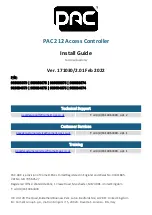
Important:
The
ASRCP
bits in the
ACCTL
register must be set before using the analog comparators.
22.3.1
Internal Reference Programming
The structure of the internal reference is shown in Figure 22-3 on page 1656. The internal reference
is controlled by a single configuration register (
ACREFCTL
).
Figure 22-3. Comparator Internal Reference Structure
N*R
N*R
0x0
0x1
0xE
0xF
Decoder
internal
reference
V
IREF
Note:
In the figure above, N*R represents a multiple of the R value that produces the results specified
in Table 22-2 on page 1656.
The internal reference can be programmed in one of two modes (low range or high range) depending
on the
RNG
bit in the
ACREFCTL
register. When
RNG
is clear, the internal reference is in high-range
mode, and when
RNG
is set the internal reference is in low-range mode.
In each range, the internal reference, V
IREF
, has 16 preprogrammed thresholds or step values. The
threshold to be used to compare the external input voltage against is selected using the
VREF
field
in the
ACREFCTL
register.
In the high-range mode, the V
IREF
threshold voltages start at the ideal high-range starting voltage
of V
DDA
/4.2 and increase in ideal constant voltage steps of V
DDA
/29.4.
In the low-range mode, the V
IREF
threshold voltages start at 0 V and increase in ideal constant
voltage steps of V
DDA
/22.12. The ideal V
IREF
step voltages for each mode and their dependence
on the
RNG
and
VREF
fields are summarized in Table 22-2.
Table 22-2. Internal Reference Voltage and ACREFCTL Field Values
Output Reference Voltage Based on VREF Field Value
ACREFCTL Register
RNG
Bit Value
EN
Bit Value
0 V (GND) for any value of
VREF
. It is recommended that
RNG
=1 and
VREF
=0 to
minimize noise on the reference ground.
RNG
=X
EN
=0
June 18, 2014
1656
Texas Instruments-Production Data
Analog Comparators
















































